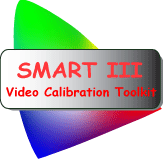SMART III - Video Calibration Toolkit
Steve Smallcombe's SMARTAVTWEAKS site

SMART
III version 2.0.
SMART III version 2.0 has several new features associated with the analysis
of gamma tracking. The gamma tracking graphs and calculations have been
improved and have been extended to lower IRE levels.
SMART now can also now be used with sources for IRE windows other than
Avia. The IRE levels on Avia were not at the nominal levels, e.g. IRE
10 was actually approximately IRE 2.7. SMART III has always corrected
its graphs and calculations for the actual IRE level present on the Avia
disk and thus could not be used with IRE window sources that had “nominal”
IRE levels without getting incorrect gamma tracking. Version 2.0 now supports
both sources of IRE windows and a check box can be used to select the
appropriate source. If you are using Avia, keep the box checked, otherwise,
uncheck it.
Several new models are now supported including Panasonic projectors. The
Panasonic version has been recently tested with the 500U and 700U Panasonic
projectors.
With the introduction of SMART III version 2.0, I am placing less emphasis
on projector specific versions, and instead have created a single spreadsheet
that will actually handle all projector types, with the user selecting
a check box in the spreadsheet for the appropriate family of projectors,
e.g. SONY LCD, Sanyo LCD, Panasonic LCD, DLP, etc.
With more and more projectors having all the relevant gain and bias and
perhaps gamma control in the user menu, there is far less need for projector
specific instructions, e.g. how to enter the service menu. Most of today’s
projectors can be tweaked using only readily accessible user controls,
thus projector specific manuals are no longer really necessary. The manual
tells you how to recognize the “gain” and “bias”
controls on your particular projector. For those hard to tweak projectors,
there is a manual addendum with lots of specific advice on use of the
factory menu for those difficult cases.
By selecting the family of projectors, e.g. DLP or Panasonic LCD, SMART
is able to make projector (family) specific corrections to color balance
so that the “default” values we calibrate for your particular
meter will be appropriate for your particular projector.
While in previous versions, SMART would suggest changes to the gain settings, it was tricky getting that right as not all controls are as linear as one might like, and it might take several iterations (measurement runs) for things to converge. I found that experienced people, myself included, were as often as not, doing mini runs at IRE 70 to save time in the process of getting the color balance right at the mid to high IRE levels.
Version 2.0 has changed this philosophy and now relies entirely on the Target Lux calculator for setting gains. This is really much more efficient than using measurement runs, as the with the Target Lux calculator one can simply look at the lux reading on the meter with the appropriate filter in place, and adjust the projector’s gain until the target lux value is achieved. That is certainly the way I have been doing it for some time.
Introduction to how SMART works
Frequently Asked Questions about SMART
Here is what's new is SMART III version 1.2
The Dummies Guide explains the SMART process in a non-technical way
Buy SMART III at EnhancedHT - your exclusive source for all SMART products
Having trouble? Learn the most common mistakes people make using SMART
Read about using bias lights to improve perceived black levels.
Here are some additional tips for the SONY projectors and solution to common problems.